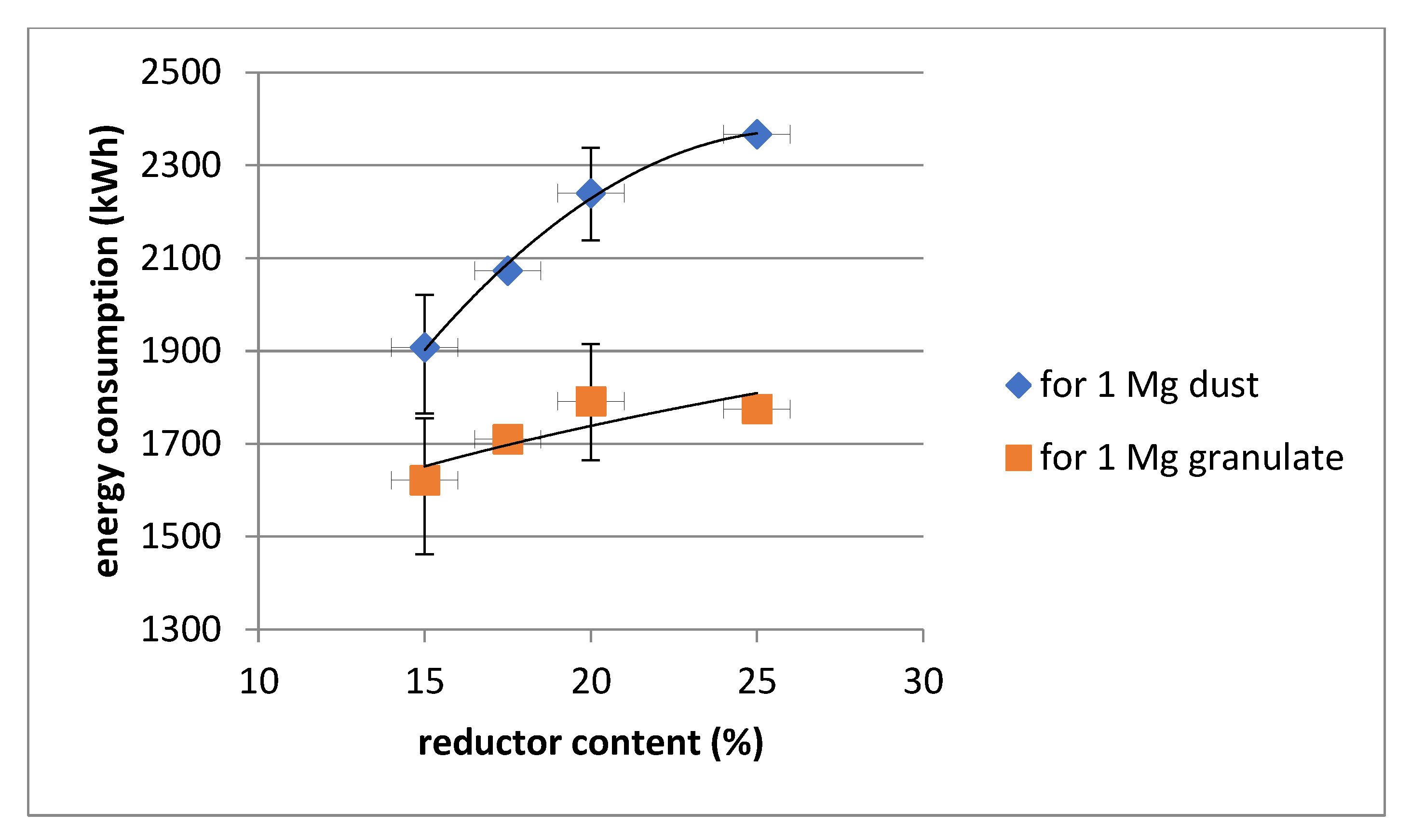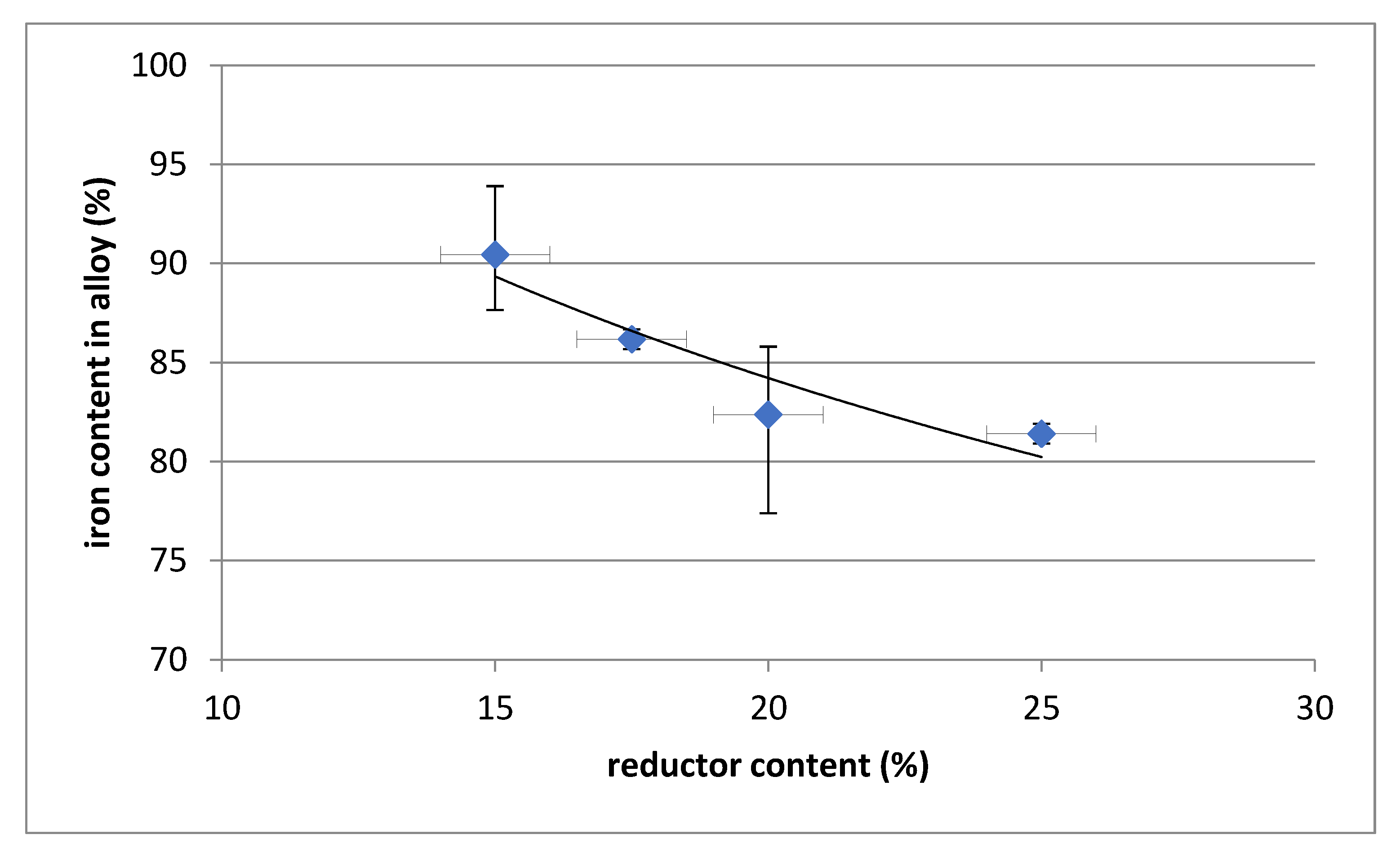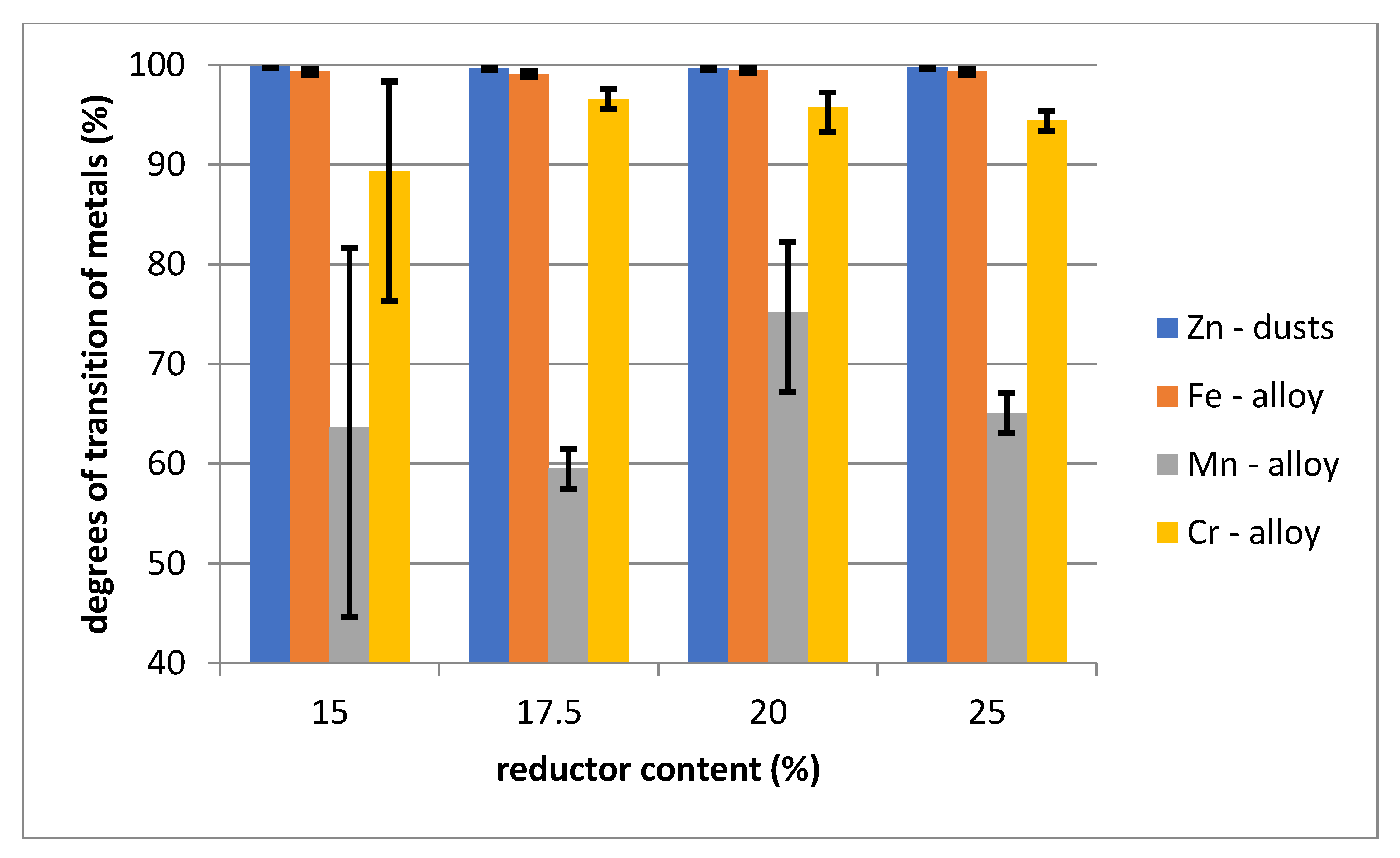High-Performance Method of Recovery of Metals from EAF Dust—Processing without Solid Waste
Abstract
:1. Introduction
2. Research Methodology
- Electric arc-resistance furnace with a core area of 0.16 m2;
- Afterburning chamber, which is a horizontal section of the gas extraction pipeline behind the furnace;
- Pre-dusting chamber and gas pre-cooling chamber;
- Fabric filter;
- Fan.
- Periodic batching (4 times, every 20 min) and solid reduction of 200 kg of granules at 1250–1300 °C and a time of about 4 h;
- Reduction of liquid slag at 1400–1500 °C for 1.0–2.0 h;
- Drainage of metallic iron and slag at 1450–1550 °C into flat ingot moulds lined with refractory concrete with a zero opening;
- Zinc vapour combustion and CO afterburning in the furnace gas space, extraction pipeline and afterburning chamber by free atmospheric air intake through slots;
- Cooling of the process gases and pre-dusting in a cyclone cooler;
- De-dusting of the process gases in a bag filter.
- Time of each operation;
- The temperature of the products;
- Slag during solid reduction (lance with Pt-RhPt thermocouple);
- Slag before final discharge (optical pyrometer and lance with Pt-RhPt thermocouple);
- Slag and metal at the discharge chute with an optical pyrometer;
- Gas temperature;
- In the afterburning chamber;
- Behind the cooling chamber;
- Before the bag filter;
- Electricity consumption meter status at the beginning, at the beginning of each batch charging, after slag reduction, and after slag and metal discharge;
- Current, voltage at electrodes, power on secondary side;
- Consumption of electrodes by weighing the new electrodes inserted and the waste after cutting off the consumed electrodes;
- Continuous measurement of the composition of the gases in the afterburning chamber with the Siemens apparatus: CO2, O2, CO, SO2, H2;
- Continuous measurement of the gas composition before the bag filter: CO2, O2, CO, SO2, NO2;
- Periodic measurement of gas flow;
- Periodic measurement of dust content in gases in the melting phase (charging and reduction in the solid state) and in the liquid slag reduction phase.
3. Tests Results and Discussion
- The zinc balance was made based on the contents of this metal in the charge and in the alloy and slag. Since only low content of this metal in the smelt and slag was obtained, the error in determining the amount of zinc in these phases is very small. Assuming that the remaining zinc goes to dust, a zinc transition rate of 99.3% was obtained from the charge to ZnO dust;
- The iron balance was made based on the content of this metal in the batch and in dust and slag. Their low content in the listed smelting products does not significantly affect the error in determining the amount of iron in the alloy. The transfer of iron into the alloy calculated on this basis is 98.5%;
- Based on the above calculations obtained from 1 Mg of steelmaking dust, the average amounts of the individual products will be: 360 kg ZnO dust, 400 kg alloy and 120 kg slag.
4. Conclusions
- The most favourable effects of the processing of steelmaking dust in the arc-resistance furnace were obtained with the use of a reducer in the amount of 15% in relation to the weight of dust. This is particularly evident in the specific energy consumption, which averaged just over 1600 kWh/Mg batch.
- A high zinc to dust phase transition (ZnO) of 99.3% was achieved. The dust represents a product with high market value.
- A high degree of iron transition to metallic alloy of 98.5% was obtained. The alloy can be easily refined to steel.
- Slags with a low total Zn + Pb + Cu content of less than 0.2% were obtained. The results from the leaching test indicate that the slag is environmentally friendly. The slag can be used as an aggregate.
- The proposed processing of steelmaking dust does not generate condensed waste.
Author Contributions
Funding
Institutional Review Board Statement
Informed Consent Statement
Data Availability Statement
Acknowledgments
Conflicts of Interest
References
- Lin, X.; Peng, Z.; Yan, J.; Li, Z.; Hwang, J.-Y.; Zhang, Y.; Li, G.; Jiang, T. Pyrometallurgical recycling of electric arc furnace dust. J. Clean. Prod. 2017, 149, 1079–1100. [Google Scholar] [CrossRef]
- Loaiza, A.; Cifuentes, S.; Colorado, H.A. Asphalt modified with superfine electric arc furnace steel dust (EAF dust) with high zinc oxide content. Constr. Build. Mater. 2017, 145, 538–547. [Google Scholar] [CrossRef]
- Rieger, J.; Colla, V.; Matino, I.; Branca, T.A.; Stubbe, G.; Panizza, A.; Brondi, C.; Falsafi, M.; Hage, J.; Wang, X.; et al. Residue Valorization in the Iron and Steel Industries: Sustainable Solutions for a Cleaner and More Competitive Future Europe. Metals 2021, 11, 1202. [Google Scholar] [CrossRef]
- Machado, J.G.M.S.; Brehm, F.A.; Moraes, C.A.M.; dos Santos, C.A.; Vilela, A.C.F.; da Cunha, J.B.M. Chemical, physical, structural and morphological characterization of the electric arc furnace dust. J. Hazard. Mater. 2006, 136, 953–960. [Google Scholar] [CrossRef]
- Chen, W.S.; Shen, Y.H.; Tsai, M.S.; Chang, F.C. Removal of chloride from electric arc furnace dust. J. Hazard. Mater. 2011, 190, 639–644. [Google Scholar] [CrossRef]
- Li, C.L.; Tsai, M.S. A crystal phase study of zinc hydroxide chloride in electric-arc-furnace dust. J. Mater. Sci. 1993, 28, 4562–4570. [Google Scholar] [CrossRef]
- Quijorna, N.; de Pedro, M.; Romero, M.; Andrés, A. Characterisation of the sintering behaviour of Waelz slag from electric arc furnace (EAF) dust recycling for use in the clay ceramics industry. J. Environ. Manag. 2014, 132, 278–286. [Google Scholar] [CrossRef] [Green Version]
- Galchinetskii, L.P.; Galkin, S.N.; Ryzhikov, V.D.; Rybalka, I.A.; Voronkin, E.F.; Lalayants, A.I.; Starzhinskii, N.G.; Silin, V.I. Chemical interaction in the ZnSe-ZnTe-Se-H2-C system. J. Environ. Manag. 2014, 143, 208–213. [Google Scholar] [CrossRef]
- Vogelbacher, M.; Keller, S.; Zehm, W.; Matthes, J. Advanced Methods for Kiln-Shell Monitoring to Optimize the Waelz Process for Zinc Recycling. Processes 2021, 9, 1062. [Google Scholar] [CrossRef]
- Muica, V.-T.; Ozunu, A.; Török, Z. Comparative Life Cycle Impact Assessment between the Productions of Zinc from Conventional Concentrates versus Waelz Oxides Obtained from Slags. Sustainability 2021, 13, 580. [Google Scholar] [CrossRef]
- Zhang, M.; Li, J.; Zeng, Q.; Mou, Q. An Experimental Study on the Reduction Behavior of Dust Generated from Electric Arc Furnace. Appl. Sci. 2019, 9, 3604. [Google Scholar] [CrossRef] [Green Version]
- Huda, N.; Naser, J.; Brooks, G.; Reuter, M.A.; Matusewicz, R.W. Computational fluid dynamic modelling of zinc slag fuming process in top-submerged lance smelting furnace. Metall. Mater. Trans. B Process. Metall. Mater. Process. Sci. 2012, 43, 39–55. [Google Scholar] [CrossRef]
- Wu, C.; Chang, F.-C.; Chen, W.-S.; Tsai, M.-S.; Wang, Y.-N. Reduction behavior of zinc ferrite in EAF-dust recycling with CO gas as a reducing agent. J. Environ. Manag. 2014, 143, 208–213. [Google Scholar] [CrossRef] [PubMed]
- García-Baños, B.; Catalá-Civera, J.M.; Sánchez, J.R.; Navarrete, L.; López-Buendía, A.M.; Schmidt, L. High Temperature Dielectric Properties of Iron- and Zinc-Bearing Products during Carbothermic Reduction by Microwave Heating. Metals 2020, 10, 693. [Google Scholar] [CrossRef]
- Willms, T.; Echterhof, T.; Steinlechner, S.; Aula, M.; Abdelrahim, A.; Fabritius, T.; Mombelli, D.; Mapelli, C.; Preiss, S. Investigation on the Chemical and Thermal Behavior of Recycling Agglomerates from EAF by-Products. Appl. Sci. 2020, 10, 8309. [Google Scholar] [CrossRef]
- Grudinsky, P.I.; Zinoveev, D.V.; Dyubanov, V.G.; Kozlov, P.A. State of the Art and Prospect for Recycling of Waelz Slag from Electric Arc Furnace Dust Processing. Inorg. Mater. Appl. Res. 2019, 10, 1220–1226. [Google Scholar] [CrossRef]
- Branca, T.A.; Colla, V.; Algermissen, D.; Granbom, H.; Martini, U.; Morillon, A.; Pietruck, R.; Rosendahl, S. Reuse and Recycling of By-Products in the Steel Sector: Recent Achievements Paving the Way to Circular Economy and Industrial Symbiosis in Europe. Metals 2020, 10, 345. [Google Scholar] [CrossRef] [Green Version]
- Pickles, C.A. Thermodynamic analysis of the separation of zinc and lead from electric arc furnace dust by selective reduction with metallic iron. Sep. Purif. Technol. 2008, 59, 115–128. [Google Scholar] [CrossRef]
- Lundkvist, K.; Rosendahl, S.; Nyman, F.; Bölke, K.; Gustavsson, L.; Söderström, D.; Wedholm, A. OXYFINES Technique for Upgrading Zinc Containing Blast Furnace Sludge—Part 1: Pilot Trials. Metals 2020, 10, 1468. [Google Scholar] [CrossRef]
- She, X.; Wang, J.; Wang, G.; Xue, Q.; Zhang, X. Removal mechanism of Zn, Pb and alcalis from metallurgical dusts in direct reduction process. J. Iron Steel Res. Int. 2014, 21, 488–495. [Google Scholar] [CrossRef]
- Nakayama, M. EAF dust treatment for high metal recovery. SEAISI Q. 2012, 41, 22–26. [Google Scholar]
- Palimąka, P.; Pietrzyk, S.; Stępień, M.; Ciećko, K.; Nejman, I. Zinc Recovery from Steelmaking Dust by Hydrometallurgical Methods. Metals-Open Access Metall. J. 2018, 8, 547. [Google Scholar] [CrossRef] [Green Version]
- Hyk, W.; Kitka, K.; Rudnicki, D. Selective Recovery of Zinc from Metallurgical Waste Materials from Processing Zinc and Lead Ores. Molecules 2019, 24, 2275. [Google Scholar] [CrossRef] [Green Version]
- Du, Y.; Tong, X.; Xie, X.; Zhang, W.; Yang, H.; Song, Q. Recovery of Zinc and Silver from Zinc Acid-Leaching Residues with Reduction of Their Environmental Impact Using a Novel Water Leaching-Flotation Process. Minerals 2021, 11, 586. [Google Scholar] [CrossRef]
- Maccagni, M.G. INDUTEC/EZINEX Integrate Process on Secondary Zinc-Bearing. Materials. J. Sustain. Metall. 2016, 2, 133–140. [Google Scholar] [CrossRef] [Green Version]
- Díaz, G.; Martín, D. Modified Zincex process: The clean, safe and profitable solution to the zinc secondaries treatment. Resour. Conserv. Recycl. 1994, 10, 43–57. [Google Scholar] [CrossRef]
- Al-Harahsheh, M. Thermodynamic analysis on the thermal treatment of electric arc furnace dust–PVC blends. Arab. J. Sci. Eng. 2018, 43, 5757–5769. [Google Scholar] [CrossRef]
- Hamanna, C.; Spankab, M.; Stollea, D.; Auerb, G.; Weingarta, E.; Al-Sabbaghc, D.; Ostermannd, M.; Adama, C. Recycling of blast-furnace sludge by thermochemical treatment with spent iron(II) chloride solution from steel pickling. J. Hazard. Mater. 2021, 402, 123511. [Google Scholar] [CrossRef]
- Warzecha, M.; Hutny, A.; Stradomski, G.; Małecki, S.; Gargul, K.; Jarosz, P.; Dobrzyński, M. Sposób Odzysku Cynku i Stopu Żelaza z Pyłów Hutniczych. Patent Application (PL) P. 424985, 2018. [Google Scholar]
- U.S. Environmental Protection Agency (EPA). Test Method for Evaluating Solid Waste, Physical/Chemical Methods, 3rd ed.; Document no. SW-846; EPA: Washington, DC, USA, 2008.
- Gargul, K.; Handzlik, P.; Palimąka, P.; Pawlik, A. The application of citric acid solutions for selective removal of zinc from steelmaking dust. J. Min. Metall. Sect. B Metall. 2021, 57, 163–173. [Google Scholar] [CrossRef]






| Element | Fe | Zn | Pb | Mn | Si | Cu | Cr | Ca | Cl |
|---|---|---|---|---|---|---|---|---|---|
| wt.% | 36.69 | 23.95 | 1.24 | 4.44 | 1.74 | 0.18 | 0.30 | 4.35 | 0.87 |
| Parameters | Unit | Smelt 1 | Smelt 2 | Smelt 3 | Smelt 4 | Smelt 5 | Smelt 6 | Smelt 7 | Smelt 8 |
|---|---|---|---|---|---|---|---|---|---|
| reductor content | % | 15 | 15 | 15 | 17.5 | 20 | 20 | 20 | 25 |
| total smelting time | h:min | 05:05 | 05:30 | 06:05 | 05:35 | 06:40 | 05:40 | 06:10 | 05:50 |
| solid state reduction time | h:min | 03:55 | 04:00 | 04:00 | 04:00 | 05:10 | 04:00 | 04:00 | 04:00 |
| slag reduction time | h:min | 01:10 | 01:30 | 02:05 | 01:35 | 01:30 | 01:40 | 02:10 | 01:50 |
| average temp. of the reduction in solid state | °C | 1268 | n.a. | 1266 | 1314 | 1233 | 1295 | 1302 | 1300 |
| average temperature of slag reduction | °C | n.a. | 1412 | 1510 | 1422 | 1396 | 1525 | 1490 | 1434 |
| slag tapping temperature | °C | 1458 | 1500 | 1537 | 1467 | 1458 | 1480 | 1659 | 1553 |
| energy consumption for solid state reduction | kWh | 214 | 217 | 243 | 242 | 251 | 241 | 215 | 250 |
| energy consumption for slag reduction | kWh | 82 | 113 | 104 | 100 | 127 | 97 | 144 | 105 |
| smelting energy consumption | kWh | 296 | 330 | 347 | 342 | 378 | 338 | 359 | 355 |
| energy consumption per 1 Mg of granules | kWh | 1480 | 1650 | 1735 | 1710 | 1890 | 1690 | 1795 | 1775 |
| energy consumption per 1 Mg of steel dust | kWh | 1741 | 1941 | 2041 | 2073 | 2363 | 2113 | 2244 | 2367 |
| Content wt.% | Smelt 1 | Smelt 2 | Smelt 3 | Smelt 4 | Smelt 5 | Smelt 6 | Smelt 7 | Smelt 8 |
|---|---|---|---|---|---|---|---|---|
| Zn | 61.8 | 66.6 | 66.6 | 63.2 | 57.1 | 69.3 | 67.8 | 62.6 |
| Pb | 2.56 | 2.63 | 2.46 | 2.72 | 3.00 | 2.50 | 2.49 | 2.43 |
| Fe | 0.29 | 0.23 | 0.19 | 0.36 | 0.46 | 0.09 | 0.11 | 0.35 |
| Mn | 2.82 | 0.78 | 0.89 | 1.89 | 2.10 | 0.57 | 0.80 | 2.30 |
| K | 3.41 | 3.31 | 3.41 | 3.48 | 3.40 | 3.34 | 3.33 | 3.24 |
| Na | <0.01 | <0.01 | <0.01 | <0.01 | 0.55 | <0.01 | <0.01 | <0.01 |
| Cl | 4.02 | 4.23 | 4.48 | 4.19 | 4.24 | 4.33 | 4.44 | 4.02 |
| F | 0.18 | 0.19 | 0.19 | 0.20 | 0.18 | 0.15 | 0.18 | 0.19 |
| S | 0.75 | 0.58 | 0.78 | 0.74 | 1.03 | 0.66 | 0.59 | 0.81 |
| Content wt.% | Smelt 1 | Smelt 2 | Smelt 3 | Smelt 4 | Smelt 5 | Smelt 6 | Smelt 7 | Smelt 8 |
|---|---|---|---|---|---|---|---|---|
| Fe | 87.65 | 93.9 | 89.8 | 77.0 | 85.8 | 77.4 | 83.9 | 81.4 |
| Mn | 5.66 | 2.06 | 1.34 | 6.96 | 6.90 | 8.22 | 6.78 | 8.37 |
| Cr | 1.16 | 0.71 | 0.60 | 0.54 | 0.78 | 0.69 | 0.85 | 0.86 |
| C | 3.89 | 1.27 | 2.46 | 4.22 | 4.17 | 3.55 | 3.44 | 4.24 |
| Si | 0.28 | 0.34 | 1.41 | 4.66 | 0.71 | 1.88 | 0.93 | 1.46 |
| Cu | 0.43 | 0.45 | 0.48 | 0.38 | 0.38 | 0.40 | 0.35 | 0.31 |
| Zn | 0.03 | 0.02 | 0.25 | 0.17 | 0.11 | 0.21 | 0.25 | 0.13 |
| Content wt.% | Smelt 1 | Smelt 2 | Smelt 3 | Smelt 4 | Smelt 5 | Smelt 6 | Smelt 7 | Smelt 8 |
|---|---|---|---|---|---|---|---|---|
| Zn | 0.04 | 0.02 | 0.02 | 0.01 | 0.01 | 0.02 | 0.01 | 0.02 |
| Pb | 0.067 | 0.0025 | <0.0025 | <0.0025 | 0.0026 | 0.0041 | <0.0025 | <0.0025 |
| Cu | 0.013 | 0.0081 | 0.0099 | 0.0061 | 0.0072 | 0.0078 | 0.0082 | 0.0085 |
| Fe | 0.59 | 0.55 | 1.86 | 0.45 | 0.60 | 0.92 | 0.64 | 0.70 |
| Mn | 5.05 | 6.00 | 13.1 | 5.49 | 1.30 | 7.30 | 6.05 | 5.49 |
| Ca | 16.2 | 16.4 | 16.6 | 18.2 | 17.4 | 16.4 | 17.0 | 18.7 |
| Mg | 6.94 | 6.96 | 5.12 | 5.98 | 6.51 | 7.30 | 6.87 | 5.92 |
| Al | 4.49 | 4.02 | 2.88 | 4.34 | 7.26 | 3.49 | 3.67 | 3.99 |
| Si | 15.4 | 15.0 | 12.6 | 15.4 | 15.5 | 14.2 | 14.9 | 15.3 |
| Element | Concentration (mg/L) | Max. Concentration (mg/L) |
|---|---|---|
| Zn | 0.093 | 250 |
| As | <0.1 | 5 |
| Ba | 1.74 | 100 |
| Cd | <0.1 | 1 |
| Cr | 0.029 | 5 |
| Pb | 0.651 | 5 |
| Hg | - | 0.2 |
| Se | - | 1 |
| Ag | 0.012 | 5 |
Publisher’s Note: MDPI stays neutral with regard to jurisdictional claims in published maps and institutional affiliations. |
© 2021 by the authors. Licensee MDPI, Basel, Switzerland. This article is an open access article distributed under the terms and conditions of the Creative Commons Attribution (CC BY) license (https://creativecommons.org/licenses/by/4.0/).
Share and Cite
Małecki, S.; Gargul, K.; Warzecha, M.; Stradomski, G.; Hutny, A.; Madej, M.; Dobrzyński, M.; Prajsnar, R.; Krawiec, G. High-Performance Method of Recovery of Metals from EAF Dust—Processing without Solid Waste. Materials 2021, 14, 6061. https://doi.org/10.3390/ma14206061
Małecki S, Gargul K, Warzecha M, Stradomski G, Hutny A, Madej M, Dobrzyński M, Prajsnar R, Krawiec G. High-Performance Method of Recovery of Metals from EAF Dust—Processing without Solid Waste. Materials. 2021; 14(20):6061. https://doi.org/10.3390/ma14206061
Chicago/Turabian StyleMałecki, Stanisław, Krzysztof Gargul, Marek Warzecha, Grzegorz Stradomski, Artur Hutny, Mateusz Madej, Michał Dobrzyński, Ryszard Prajsnar, and Grzegorz Krawiec. 2021. "High-Performance Method of Recovery of Metals from EAF Dust—Processing without Solid Waste" Materials 14, no. 20: 6061. https://doi.org/10.3390/ma14206061
APA StyleMałecki, S., Gargul, K., Warzecha, M., Stradomski, G., Hutny, A., Madej, M., Dobrzyński, M., Prajsnar, R., & Krawiec, G. (2021). High-Performance Method of Recovery of Metals from EAF Dust—Processing without Solid Waste. Materials, 14(20), 6061. https://doi.org/10.3390/ma14206061








